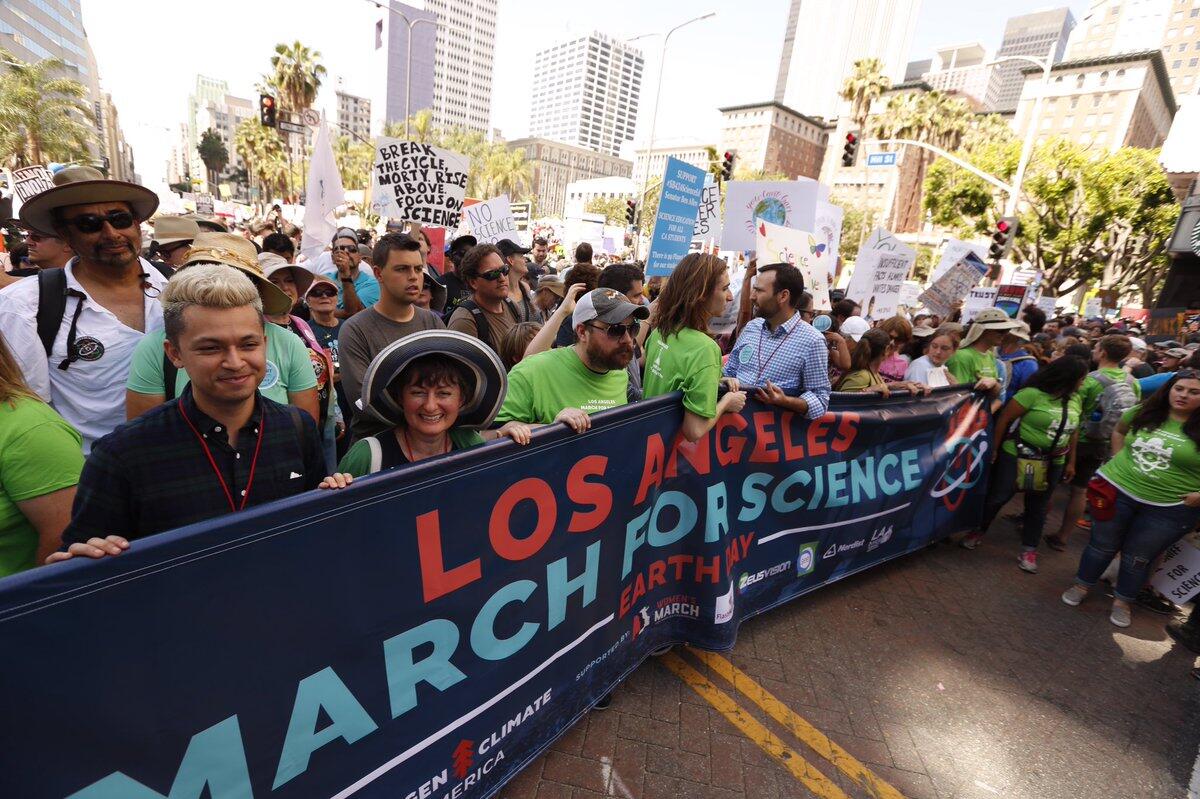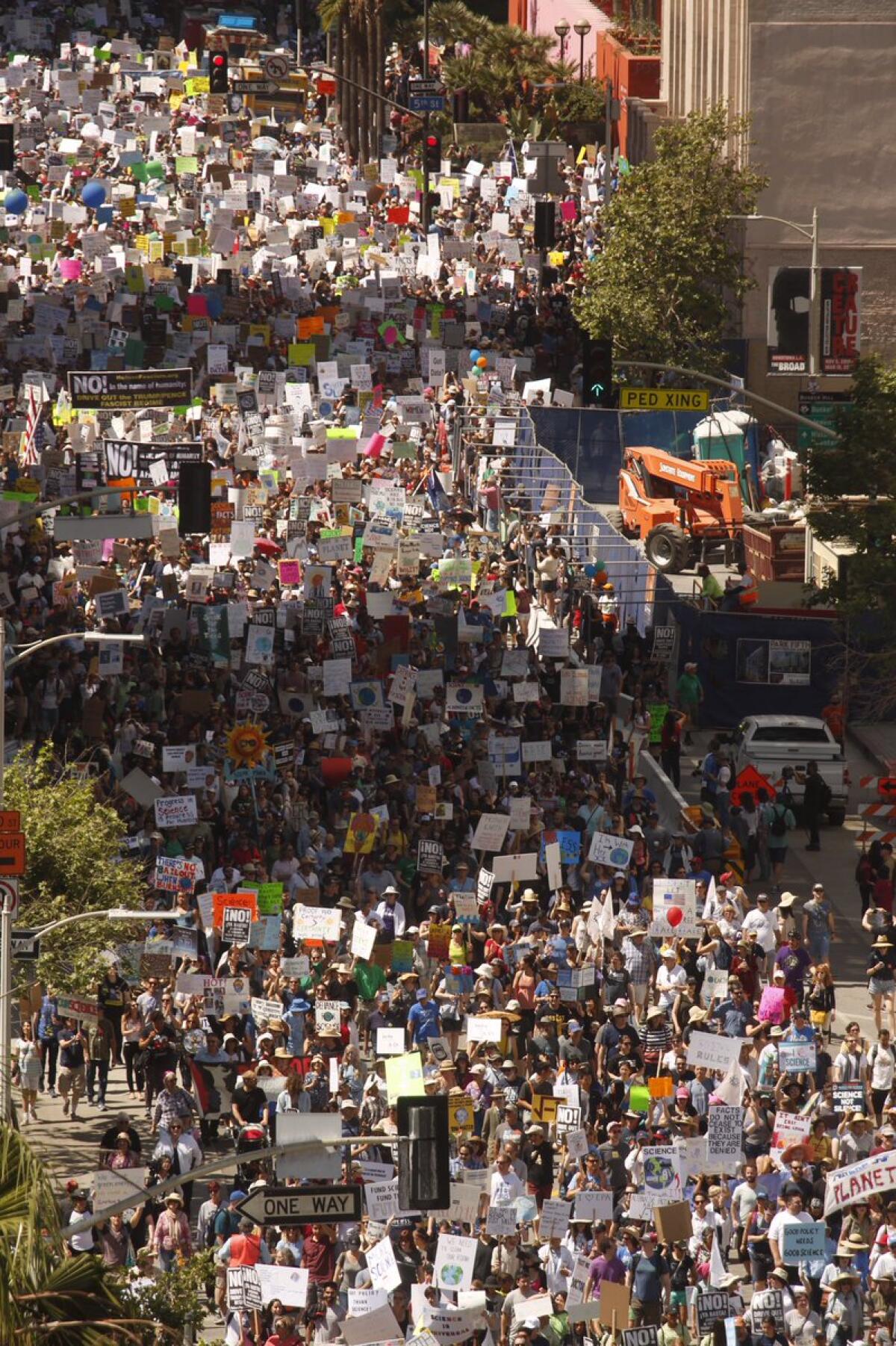More than 500 cities around the world, including 40 in California, hosted a March for Science on Saturday. In Los Angeles, thousands descended on downtown. High-profile speakers included seismologist Lucy Jones and billionaire climate change activist Tom Steyer.
But what does a March for Science even mean? And what did the attendees hope to accomplish? To answer these questions and more, our reporters Deborah Netburn and Javier Panzar and photographer Genaro Molina braved the heat and the science-believing masses. Follow their journey below:
- Marchers ignore Trump supporters on their way to City Hall
- No, these protesters aren’t being paid
- Get inspired by some of the best signs
- Photos: Scenes from the day
- Share via
Final thoughts from this reporter...
After the official marching part of the March for Science was over, some attendees headed over to the science expo at Pershing Square, which was kind of like a big science fair.
The event was scheduled to go until 4 p.m., but by 2:45 p.m. most of the people running the booths were feeling pretty done. It was hot out there!
Along the way, I met some Caltech graduate students teaching kids how to make solar panels with sunscreen and blackberries: the blackberry juice absorbs sunlight, while the titanium dioxide in the sunscreen converts the sun’s photons to electrons.
Then, I almost stepped over Artur Prejna, a clinical lab technician who spent the day letting people sign his lab coat, because he was slumped against a wall.
It was clearly time for this science reporter to head home.
But, what did I learn?
Mostly, that scientists trust in the scientific method and the peer review process, and they think you should too.
Science has helped us combat so many of humanity’s greatest threats, and it holds the promise of helping us even more in the fight against cancer, Alzheimer’s and climate change.
Also, having a solid working knowledge of the periodic table is a major plus when making signs.
- Share via
Deer head prop turns, er, heads at the march

There were several eccentric costumes at Saturday’s march. But few props turned heads quite like Mike Gloria’s deer head.
He found the cervine specimen at an estate sale in Hollywood a couple of weeks back with no intent of it becoming a political prop.
But when the retired 58-year-old electrician saw the science march was approaching, he figured that he had found the perfect place to bring it.
“This is what happens if we defund science,” he said walking across 1st Street toward City Hall. “Animals die off.”
Gloria carefully weaved between protesters making sure that an errant antler didn’t take out a stranger’s eye.
“This is about science, right?” he said. “Well, science and the wilderness are connected. Just love animals.”
- Share via
Here’s what Earth Day looked like in Los Angeles in 1970

Designed as an environmental teach-in day, 20 million Americans participated in the original Earth Day — with events in numerous communities and on school campuses.
This photo, by retired Los Angeles Times photographer George Fry, accompanied a story by Times writer Ed Meagher that reported:
Earth Day was marked in Los Angeles Wednesday by a host of antipollution programs and a notable absence of smog.
As the Air Pollution Control District reported barely marginal smog readings, thousands of Southland students and their elders heaped abuse upon all forms of environmental pollution.
They deployed it in speeches, exhibits, demonstrations and stunts on high school and college campuses. …
- Share via
Op-Ed: Trump’s anti-science budget will be a disaster for the nation’s bottom line
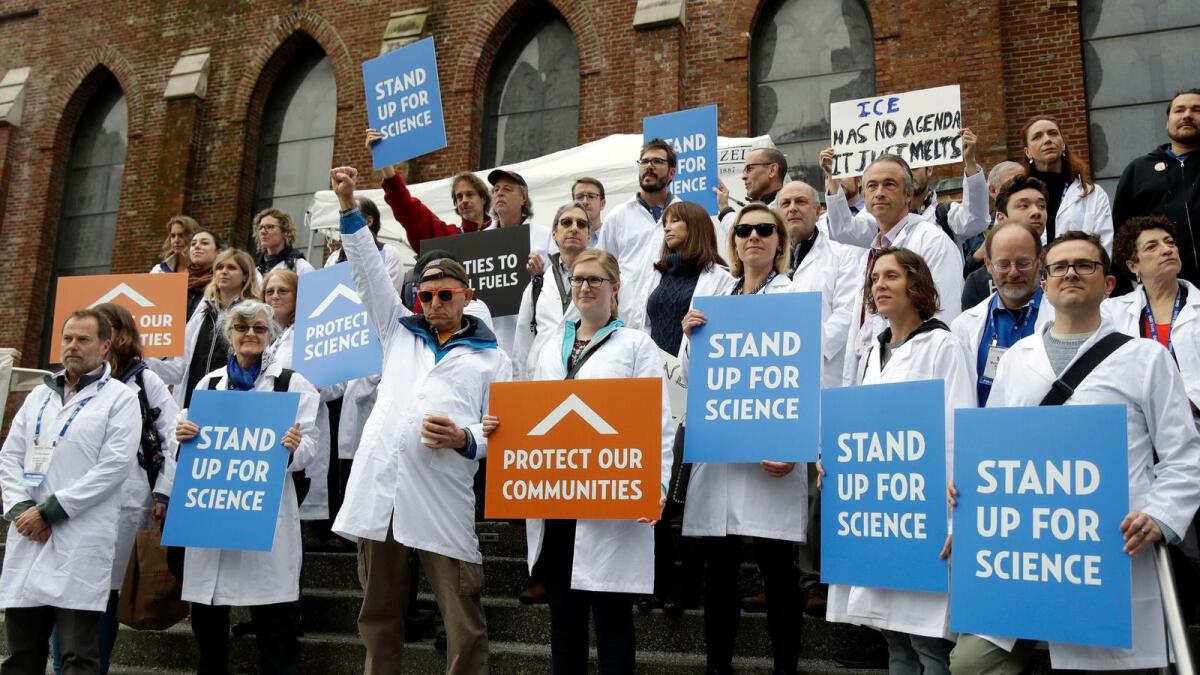
In its approach to scientific research, President Trump’s budget can be accurately described as a mugging. I’ve watched this happen before, up-close and personal. It does not end well.
In 1979, President Carter set an ambitious but achievable goal to get 20% of the nation’s energy from renewable sources by the year 2000. I then headed the federal Solar Energy Research Institute, which spearheaded the Manhattan Project to Harness the Sun. In the late 1970s, the United States had more PhDs in the solar field, filed more solar patents and made more commercial solar modules than the rest of the world combined.
In its first year, the Reagan administration slashed the solar institute’s staff by 40%, reduced its budget by 80% and abruptly terminated all of its 1,000-plus university research contracts (including shutting down work by two professors who later won Nobel Prizes). The firings were so wantonly brutal that many of the researchers were driven into other fields. The consequences have been huge.
In 2016, solar energy was the United States’ largest source of new electricity-generating capacity, contributing roughly 40% of the total from all sources. The U.S. solar industry now employs 260,000 people, more than three times as many workers as the coal industry. Most of them install and maintain photovoltaic panels that convert free, nonpolluting sunlight into power. But nearly all the solar modules these workers install are being developed and manufactured abroad. The U.S. makes just 5% of the world’s solar panels.
The U.S. ought to own the solar electric industry. By rights, we ought to be exporting solar technology, not importing it. Our second-tier status, in a field that we once absolutely dominated, is a direct consequence of budget decisions made by President Reagan’s Office of Management and Budget, and a go-along Congress.
Adjusted for inflation, the budget of the solar institute (since renamed the National Renewable Energy Laboratory) did not recover to its 1979 level until 2008. Science research can’t be revved up and down like an engine and succeed. If you pull the funding out from under a field of inquiry, it will stall and fall behind at best.
Now the Trump science budget proposes to make Reagan’s mistake all over again, across many more fields.
Denis Hayes, president and chief executive of the Bullitt Foundation, was the convener of the first Earth Day.
- Share via
Coffee bar and the shave ice man: Some only-in-L.A. moments at the march
And they all, strangely enough, involve food.
- Share via
A nearly naked Trump shows up at the March for Science
We see you.
- Share via
Meanwhile in Washington ...
Scientists and their supporters took to the streets of Washington and other cities around the world Saturday, with many expressing worries about a diminishing role for fact-based research under the Trump administration.
Waving signs with slogans like “Science is Real” and “Ask for Evidence!” the marchers gathered at the base of the Washington Monument. The crowd swelled by the thousands even as a light rain turned to a downpour.
Organizers encouraged participants to wear work gear such as their lab coats, or to dress as a science hero. Nancy Davis of Baltimore came wearing Revolutionary War-era regalia as Benjamin Franklin. She said her chemist sister approved of the tribute to the Founding Father and part-time electricity experimenter.
Marcher Jeanne Walton an eighth-grade science teacher in York, Pa., said she worried about the effects of some current political rhetoric on her young students.
“I’m watching science being denied and undermined,” said Walton, who was marching with her son, Trey, a mechanical engineering major at Temple University in Philadelphia. “We’re replacing facts with propaganda.”
- Share via
Fake or real scientists: A few of each show up at the march
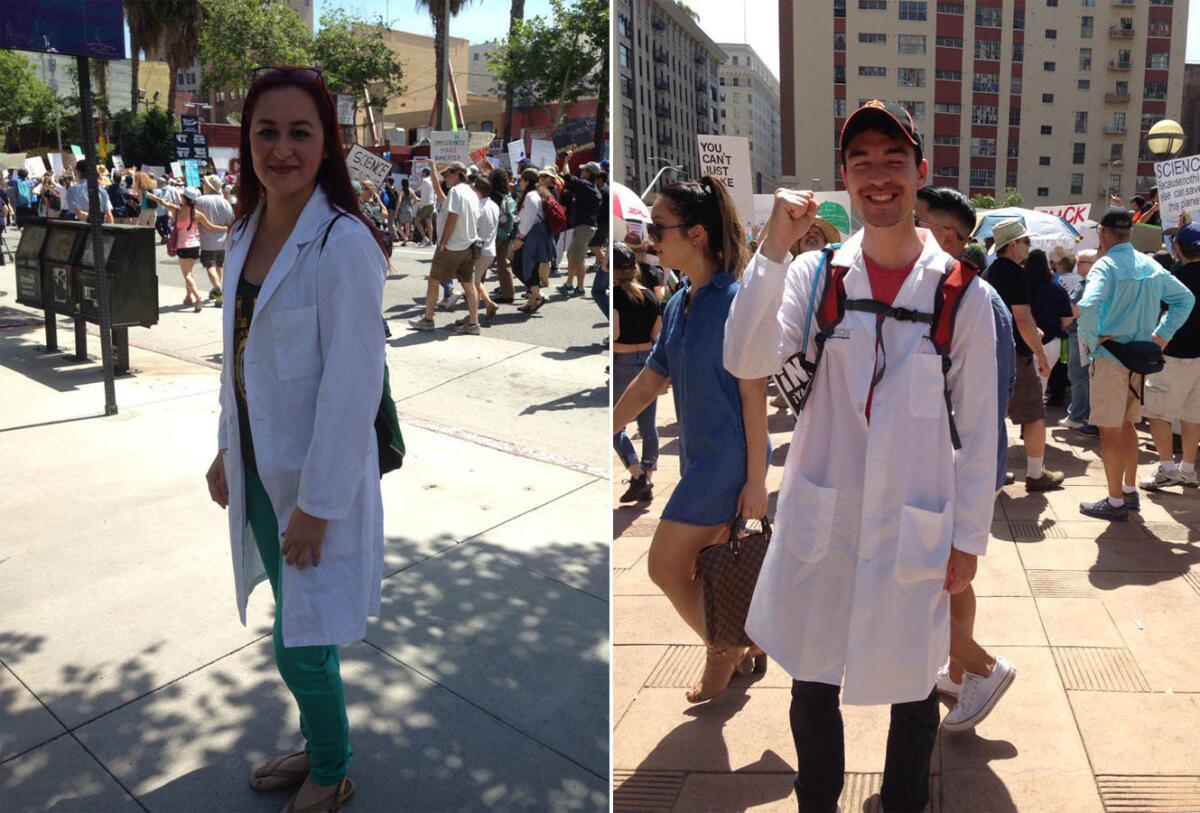
Spend a few minutes taking in the crowd at the March for Science L.A. and a few trends emerge. There are a lot of planetary models, a lot of signs that say “I’m with Her” pointing to Mother Earth, and a whole lot of white coats.
I’m a sucker for tools of the trade (after 18 years working as a journalist I still can’t believe I get to carry around a reporter’s pad for work — so official!), so I wanted to know if the white coats were real.
As it turned out, most of them were.
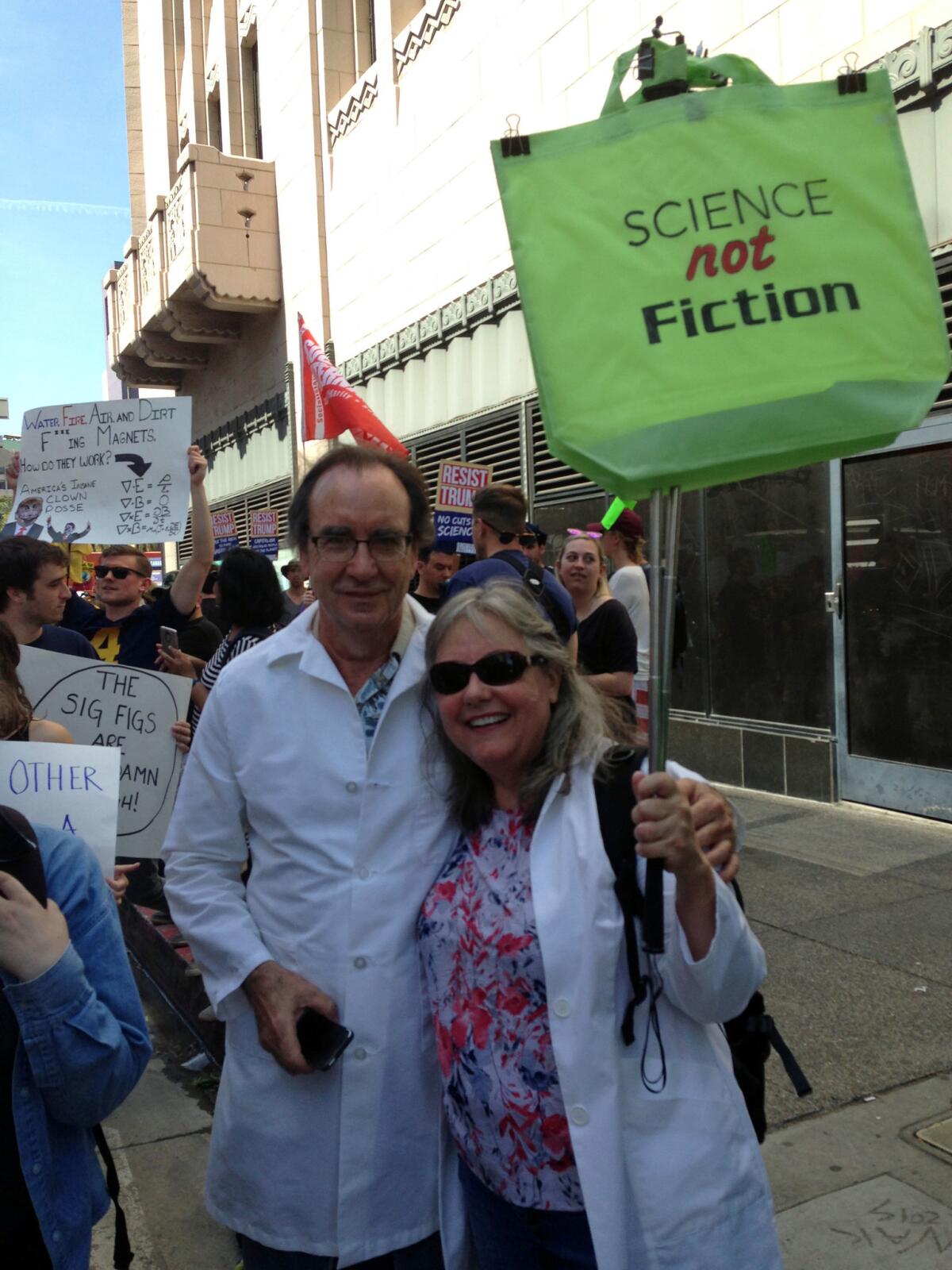
Morgan Hatch, 28, of Long Beach wears his for his job working for a biosensor company. Kimberly Prado wears hers when she works in the hematology lab of the college she attends.
And those doctors for social justice — they’ve earned theirs.
But, there were a few fakers in the crowd too. Mark Schweikart, shown at right with his wife, Maddy St. Michael, works for a company that makes telescope accessories. But the white coat was more than a prop — it was a show of solidarity with scientists.
- Share via
Can you guess what this sign means?
If not, don’t feel bad. No one here at the march could figure it out either.
But I asked. Turns out, it’s hexadecimal code for “RESIST.”
Right on, nerds!
- Share via
Spotted: Polar bear dragging his own melting ice

And Kathy Griffin turns up the heat with her simple, but to-the-point sign.
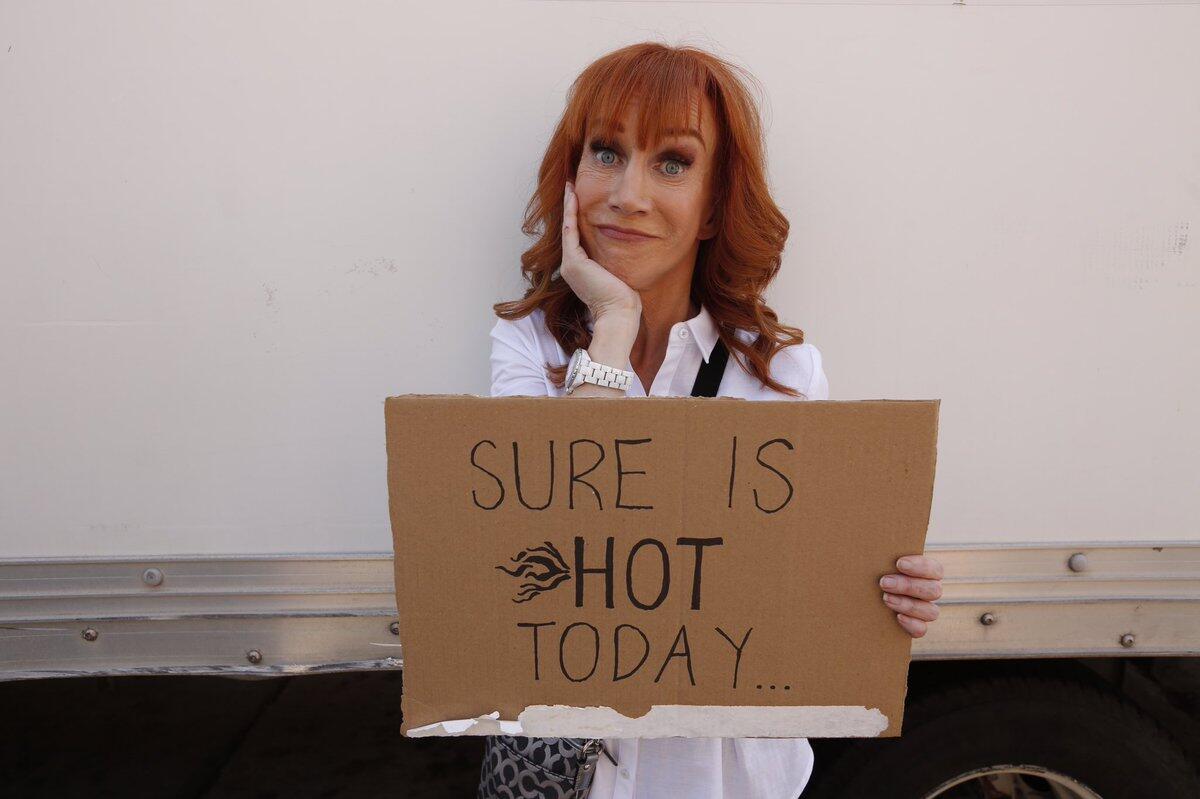
Follow me on Twitter @GenaroMolina47 for more scenes from the march.
- Share via
Trump supporters are out too, but marchers are ignoring them
Overheard at the march: “Keep going. Don’t pay any attention to them.”
About two dozen Trump supporters gathered in front of the L.A. Police Department, across the street from City Hall, to voice their support for the president. Many waved American flags and held up signs that read, “Put America First” and “Stop Your Hate.”
With several police officers standing between the two groups, the Trump supporters chanted, “U-S-A, U-S-A!” as the marchers passed in front of them at the corner of 1st and Spring streets. But the two groups were mostly peaceful and police did not report any major problems or arrests.
- Share via
Two electric Hummers lead the L.A. March for Science
On any other day, I guess this would be strange.

But look at this crowd.
- Share via
The rally is done. And L.A. marchers are headed for City Hall
- Share via
Rep. Brad Sherman and businessman Tom Steyer get the crowds pumped up
We as a species tried to go without science for 1,000 years. We called it the Dark Ages.
— Rep. Brad Sherman (D-Sherman Oaks)
There is a force in our land. There is a force coming out of Washington, D.C., called the Trump administration that is out to deny truth and bury science.
— Tom Steyer
- Share via
When it’s at least 80 degrees outside at a march
The National Weather Service predicts today will be sunny with a light wind and a high near 86 degrees.
- Share via
She’s a Mexican American scientist, ‘not a murderer, rapist or drug dealer.’ Today is her first march
She felt attacked by Trump: because her parents are immigrants from Mexico, because of Trump’s comments about assaulting women, and because her research lab is funded in part by federal grants.
I’m outraged, I’m upset. We need to be out here.
— Dr. Jeniffer Hernandez
- Share via
Celebrity seismologist Lucy Jones: We march because ‘reality matters’
Below is an op-ed written by seismologist Lucy Jones.
This is not a protest march. We march to proclaim what we believe is a fundamental tenet of human life: Reality matters.
Science is not a set of facts or even techniques and procedures. Science is a process for understanding the nature of the world. Scientists begin from the assumption that there is an objective reality, independent of our hopes and desires. We try to understand the nature of that reality through observations and experiments. We get ideas and make models from those observations and from those models, make predictions of what will happen in the future. We test the predictions against reality to see if we are right.
And then, because we know that the easiest person to fool is oneself, we take our research — our intellectual offspring, the prized result of our hard work — and put it in the hands of colleagues, or even a competitor, and ask them to tear it apart, find the flaws and tell us what we did wrong.
RELATED: Lucy Jones is leaving her job - to shake up more than just earthquakes >
The process doesn’t always work — people make mistakes or actively commit fraud. But the system is set up to make it difficult to keep fraud going. Peer review can be so difficult emotionally that many new PhDs decide they’d rather pursue a career that doesn’t involve research. This is an unfortunate downside of science’s effort to find out what is undeniably true.
And society needs the truth.
- Share via
Here are some of the best signs at the march
The organizers of today’s March for Science in Los Angeles insisted that the event was nonpartisan. But it featured many of the trappings of a political march — signs, chants and speakers riling up the crowd.
Here are just a few of the most interesting of those signs spotted in the crowd:
- These signs that bring in “Star Wars” references and give a shoutout to Albert Einstein.

- This sign, made by Melissa Arredondo, a PhD student who is just trying to feed herself.

- This sign for cat-lovers that bluntly offers a few words of advice.
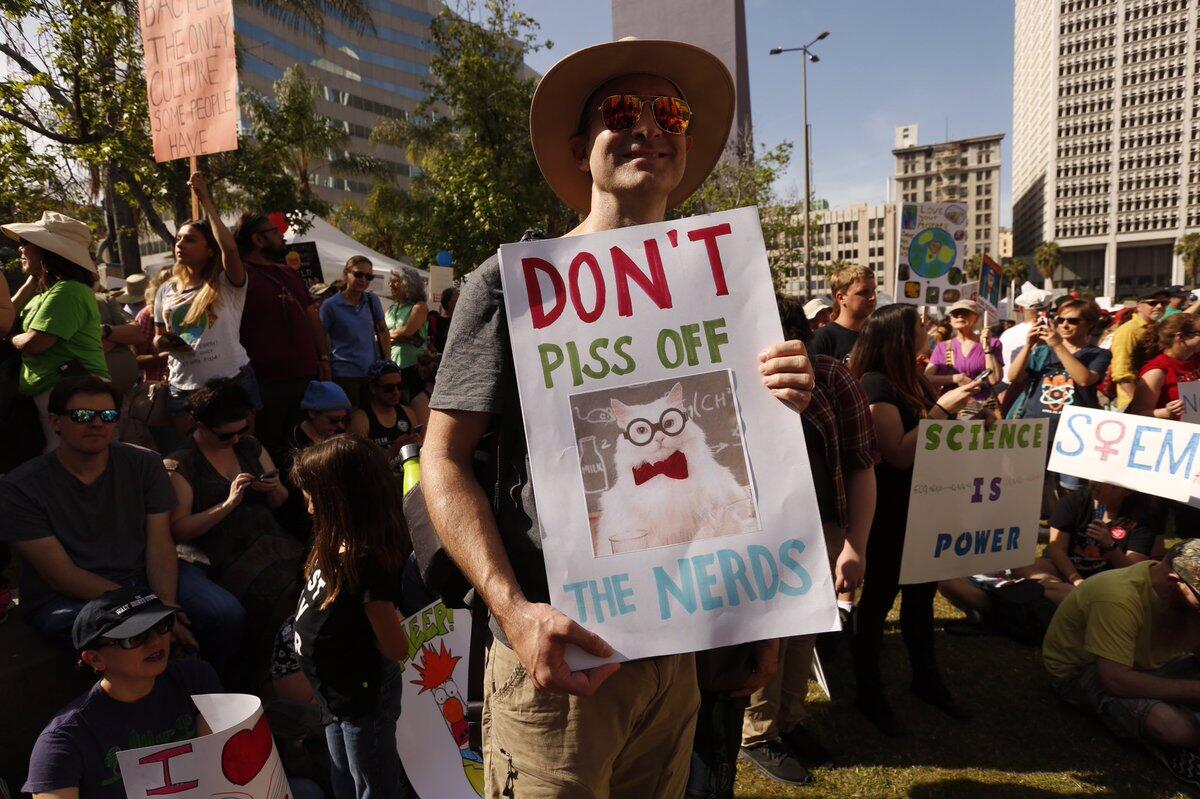
- This sign that offers up some elemental suggestions for making America great again.

- This sign as told from a four-legged point of view.
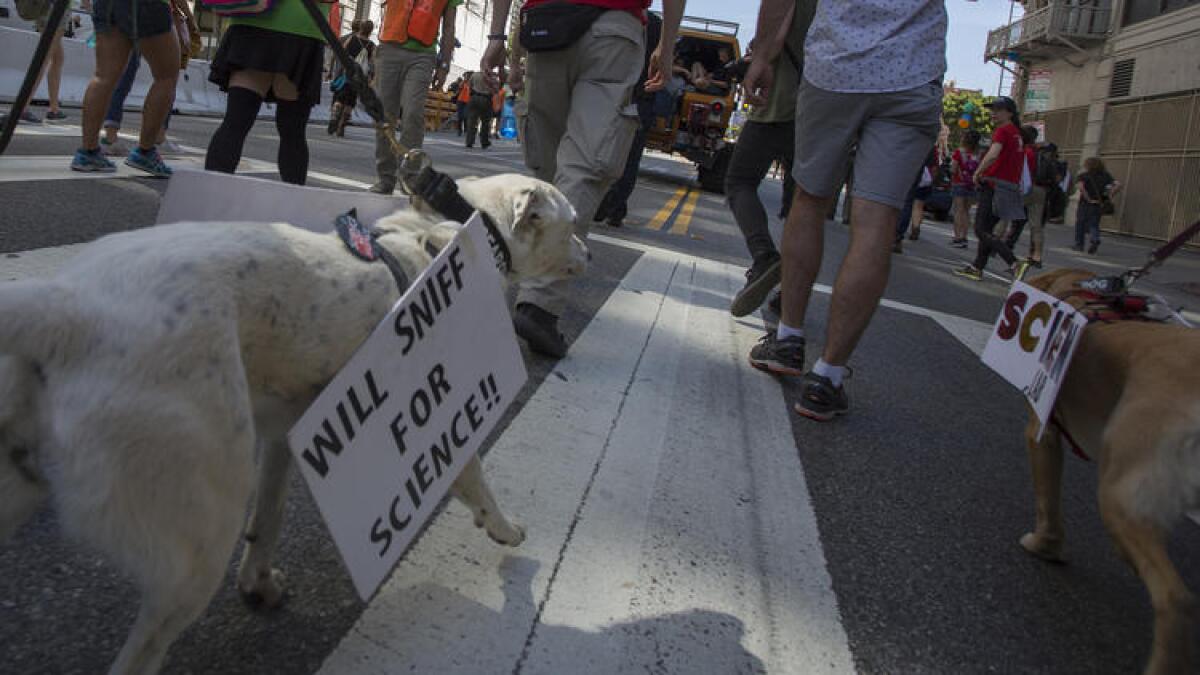
- This sign using one of Trump’s favorite sayings.

- And this sign stating the obvious.
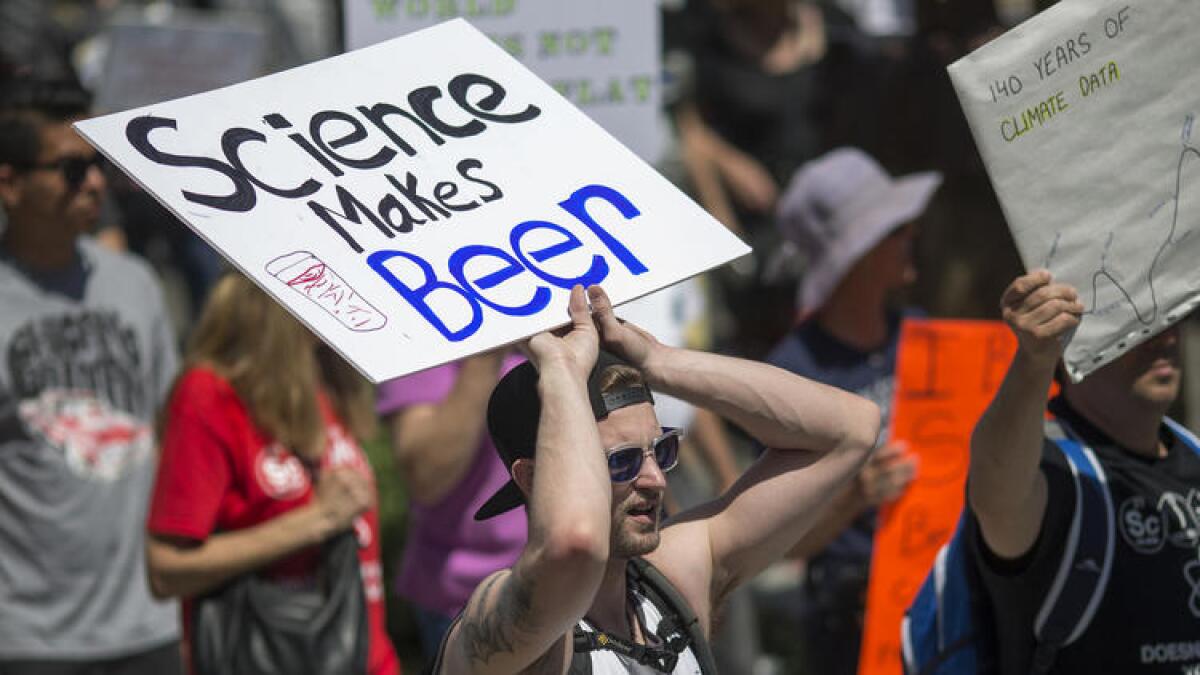
- Share via
Why ‘even the introverts are outside with people’ today
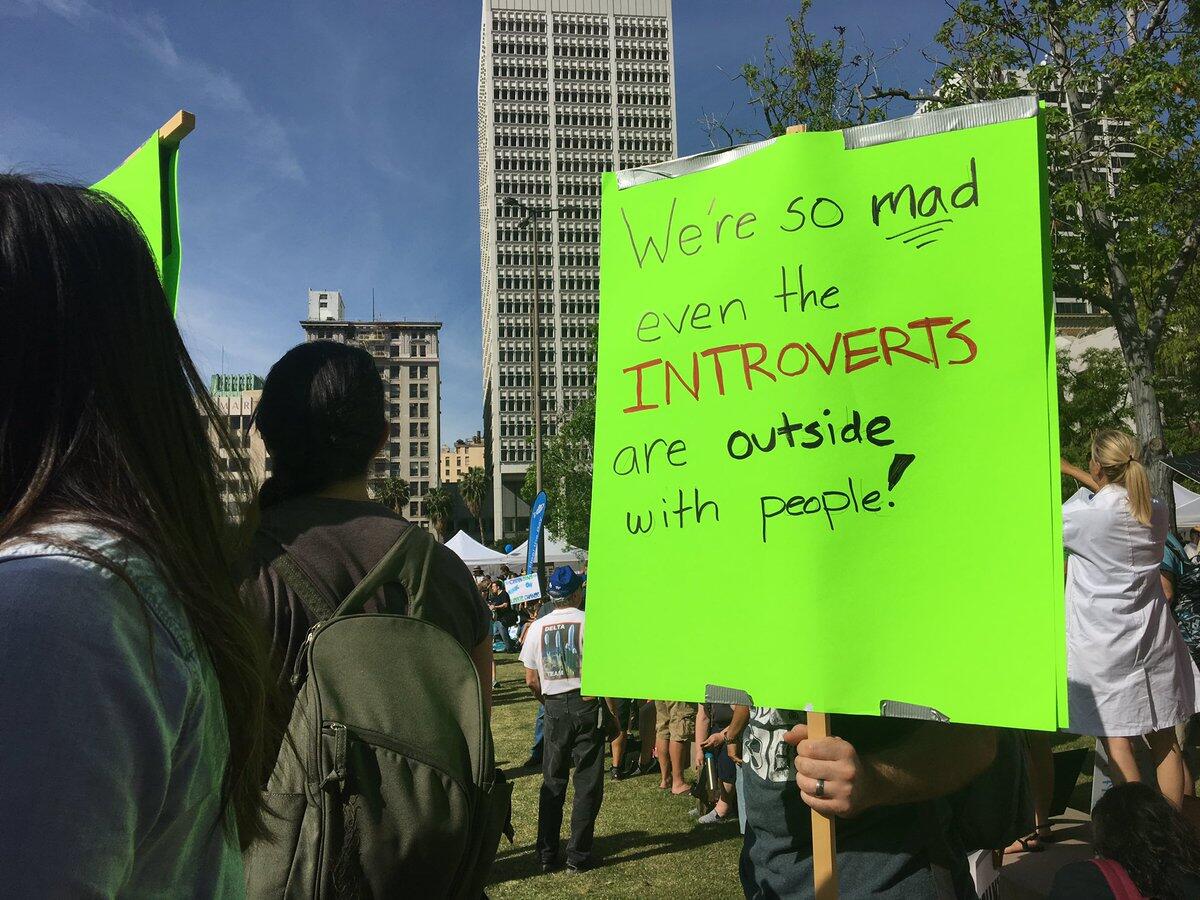
Daniel Blackburn, a software engineer from Irvine, said he is worried the U.S. under President Trump will fall behind on combating climate change through research or policy.
We are losing out on valuable time we need to actually take action.
— Daniel Blackburn, science marcher
Blackburn is channeling his newfound activism into local politics.
He said he has been calling his local Congresswoman, Rep. Mimi Walters (R-Irvine), repeatedly, but he hasn’t gotten past interns or voicemail.
Walters is one of seven congressional Republicans in California who represent districts that Hillary Clinton won in 2016 and that Democrats are targeting for defeat in 2018. Blackburn is keeping a close eye on that race.
“There is a lot of anger at her,” he said.
- Share via
These marchers are ‘absolutely not being paid to be here’
That being said, Daniel Barragan, who just graduated from University of California with a degree in chemistry, will take your money.
- Share via
Being a scientist requires objectivity. So is it OK for them to march?
It’s a legitimate question, said Alex Bradley, a PhD candidate in molecular biology at UCLA who was instrumental in organizing Saturday’s march in Los Angeles.
Luckily, he said, it has an easy answer: Standing up for science is OK.
We’re not lobbying for any specific policies. We’re just asking that policymakers consider the available evidence before making decisions.
— Alex Bradley, Los Angeles March for Science organizer
- Share via
Why we march: ‘So many reasons’
Ask anyone at the Los Angeles March for Science what brought them out Saturday and the answer is usually a sigh and then, “So many reasons.”
Sharon Stricker, 27, who works as a tutor but studied neuroscience in school, said science can bring people from different sides of the political spectrum together.
“We had Trump supporters and Bernie supporters in my house,” she said. “But science isn’t a conservative issue or a liberal issue. I want to focus on what we can accomplish as a team.”
Ryan Erickson, 28, of Crenshaw, said he was marching because he thinks facts and science should dictate policy, and he’s worried the current administration doesn’t agree.
- Share via
Our reporters are at L.A.’s March for Science. And they’re taking your questions
- Share via
Why doctors are being urged to join the March for Science
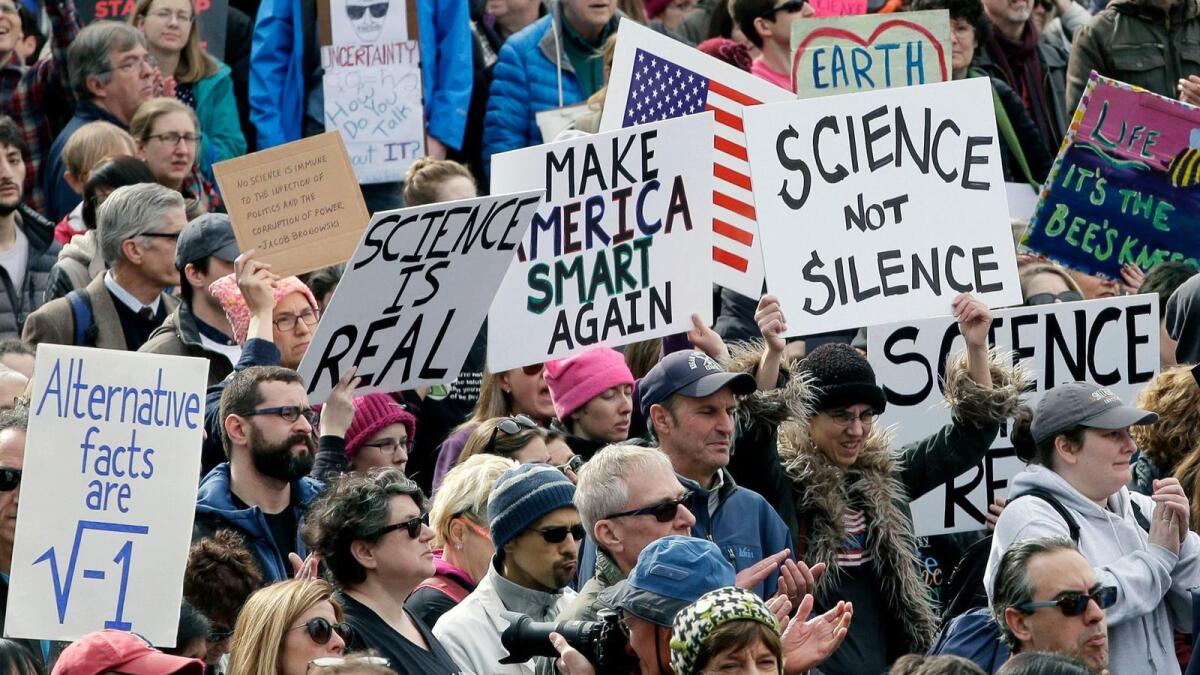
The editors of the prestigious Annals of Internal Medicine are urging their colleagues in the medical community to join Saturday’s March for Science. To make sure they leave no room for doubt, the headline on their editorial reads, “Alternative Facts Have No Place in Science.”
Published by the American College of Physicians, it’s a jam-packed piece that explains how the politicization of science is threatening the health of our nation’s citizens.
So what, exactly, has made these physicians worked up enough to participate in Saturday’s march?
Let’s start with: Climate change is not a hoax ...
“Climate change has adverse effects on human health that include respiratory disease, heat-related conditions, vector-borne disease and food and water security.”
… and its effects are being felt, right here, right now.
“These are not merely future hypothetical threats in foreign lands — poor air quality due to global warming is already associated with poor respiratory health in U.S. locales.”
Also, vaccines work…
“Well-designed and meticulous studies [have established] the effectiveness and safety of vaccines for such diseases as measles, pertussis, varicella, and polio.”
- Share via
How a stay-at-home mom and a PhD student teamed up to organize L.A.’s march
Jennifer Wheeler was scrolling through her Facebook feed at the Temple City Library while her 2-year-old played in the toy area and her 6-month-old napped in the stroller. The more she read about the newly implemented gag orders at the Environmental Protection Agency and the National Park Service, the more alarmed she became.
Then an alert flashed on her screen. A friend from Colorado had joined a March for Science group on the social media site.
Intrigued, Wheeler looked to see whether there was a March for Science group in Los Angeles. There wasn’t.
And so, right there in the library, she started one.
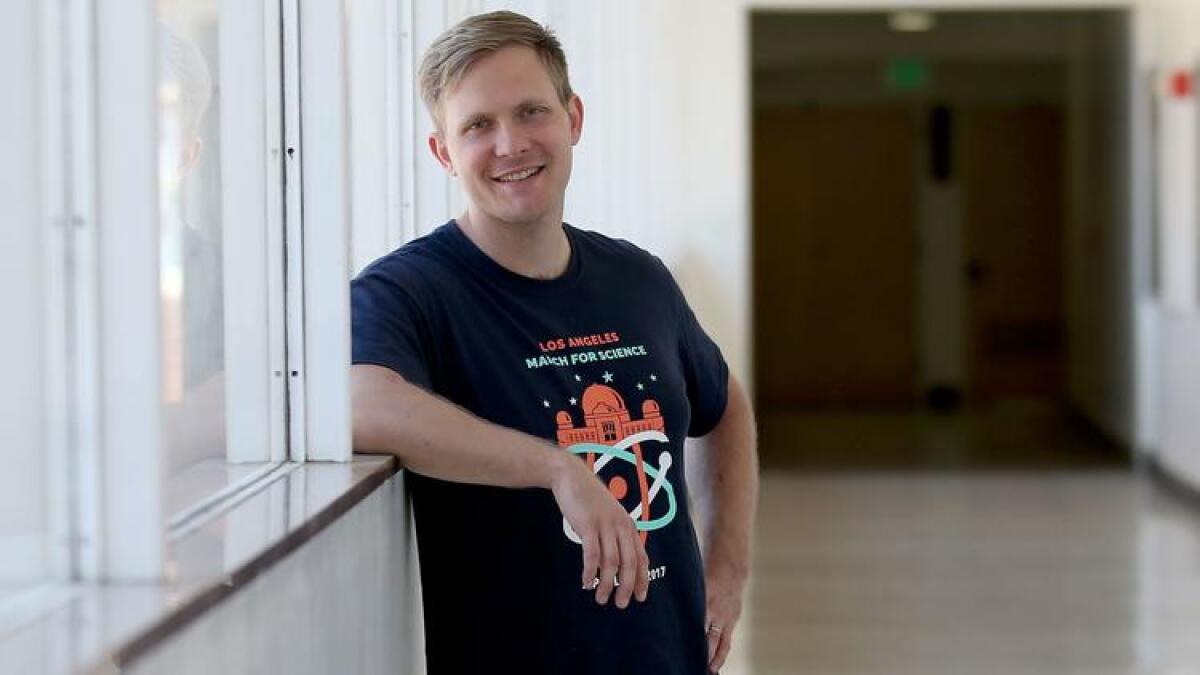
Across the city, Alex Bradley, a PhD candidate in molecular biology at UCLA, was having lunch with a friend and venting his frustrations about politicians who ignore scientific research. Again.
“I think I was putting him to sleep,” he said.
In the midst of his rant, Bradley’s friend glanced at his phone and saw that he had just been invited to attend a March for Science in San Diego.
Bradley was inspired. He had a newborn to tend to at home, and research on fruit fly oocytes to work on in his lab. But as soon as the lunch was over, he set up a private Facebook page for March for Science LA. By the end of the day the group had 2,000 members.
- Share via
Your guide to the March for Science in downtown L.A.
What’s the schedule?
9 a.m. - 4 p.m.: Science Expo
10 a.m.: Rally
11: a.m.: March
Noon: Speeches
Where is it?
The march will start in Pershing Square in downtown Los Angeles and end at City Hall.
Who will be there?
Thousands are expected to attend. Celebrity seismologist Lucy Jones, billionaire climate change activist Tom Steyer and Oscar-nominated “Hidden Figures” screenwriter Allison Schroeder are scheduled to speak.
